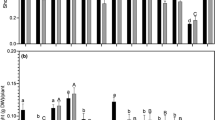Summary
Chickpea cultivars (Cicer arietinum L.) and their symbiosis with specific strains of Rhizobium spp. were examined under salt stress. The growth of rhizobia declined with NaCl concentrations increasing from 0.01 to 2% (w : v). Two Rhizobium spp. strains (F-75 and KG 31) tolerated 1.5% NaCl. Of the 10 chickpea cultivars examined, only three (Pusa 312, Pusa 212, and Pusa 240) germinated at 1.5% NaCl. The chickpea — Rhizobium spp. symbiosis was examined in the field, with soil varying in salinity from electrical conductivity (EC) 4.5 to EC 5.2 dSm-1, to identify combinations giving satisfactory yields. Significant interactions between strains and cultivars caused differential yields of nodules, dry matter, and grain. Four chickpea — Rhizobium spp. combinations, Pusa 240 and F-75 (660 kg ha-1), Pusa 240 and IC 76 (440 kg ha-1), Pusa 240 and KG 31 (390 kg ha-1), and Pusa 312 and KG 31 (380 kg ha-1), produced significantly higher grain yields in saline soil.
Similar content being viewed by others
References
Abel GH, Mackenzie AJ (1964) Salt tolerance of soybean varieties (Glycine max L. Merril) during germination and later growth. Crop Sci 4:157–161
Babu VR, Kumar S (1979) Seed germination and early seedling growth of Cicer arietinum L. cv C-235, Cajanus cajan L. Spring cv. Pusa agati, Phaseolus mungo L. cv P-1 and P. aureus cv. 8.8 under growth regulators and salinity stressed conditions. J Indian Bot Soc 58:140–158
Bernstein L, Hayward HE (1958) Physiology of salt tolerance. Annu Rev Plant Physiol 9:25–46
Bhardwaj SN, Rao IM (1960) Physiological studies on salt tolerance in crop plants: IX. Effect of sodium chloride and sodium carbonate on seedling respiration and growth of wheat and gram. Indian J Plant Physiol 3:56–71
Jordan DC (1984) Rhizobiaceae. In: Kreig NR, Holt JG (eds) Bergey's Manual of Systematic Bacteriology, vol. I. Williams and Wilkins Publications. Baltimore
Kaseem M, Capellano A, Gounot AM (1985) Effect of sodium chloride on in vitro growth, infectivity and effectiveness of Rhizobium meliloti. J Appl Microbiol Biotechnol 1:63–75
Kawasaki T, Akiba T, Moritsugu M (1983) Effect of high concentrations of sidum chloride and polyethylene glycol on the growth and ion absorption in plants: 1. Water culture experiments in a greenhouse. Plant and Soil 75:75–85
Kumar S, Promila K (1983) Effects of chloride and sulphate types of salinization and desalinization on nodulation and nitrogen fixation in chickpea. Indian J Plant Physiol 26:396–401
Lauter DJ, Munns DN, Clarkin KL (1981) Salt response of chickpea as influenced by N supply. Agron J 73:351–354
Maas EV, Hoffman GJ (1977) Crop salt toleracnce — Current assessment. Am Soc Chem Eng J (Irrig, Drain Div) 103:115–134
Maliwal KV, Paliwal GL (1973) Salt tolerance of some arhar (Cajanus indicus) species. Ann Arid Zone 12:135–143
Pillai BN, Sen A (1966) Salt tolerance of Rhizobium trifolii. Indian J Agric Sci 36:80–83
Rai R (1983) The salt tolerance of Rhizobium strains and lentil genotypes and the effect of salinity on aspects of symbiotic nitrogen fixation. J Agric Sci 100:81–86
Rudulier D La, Strom AR, Dandekar AM Smith LT, Valentine RC (1984) Molecular biology of osmoregulation. Science 224:1064–1068
Saraf CS, Davis SJ (1969) Water management for pulse crops. Symposium on Water Management, HAU, Hissar
Singleton PW (1983) A split root growth system for evaluating the effect of salinity on components of the soybean — Rhizobium japonicum symbiosis. Crop Sci 23:259–262
Sprent JI (1984) Effects of drought and salinity on heterotrophic nitrogen fixing bacteria and on infection of legumes by rhizobia. In: Veeger C, Newton WE (eds) Advances in nitrogen fixation research. Martinus Nijhoff/Dr W Junk, The Hague, pp 295–302
Subba Rao NS, Lakshmi-Kumari M, Singh CS, Magu SP (1972) Nodulation of lucerne (Medicago sativa L.) under the influence of sodium chloride. Indian J Agric Sci 42:384–386
Tu JC (1981) Effect of salinity on Rhizobium root hair interaction, nodulation and growth of soybean. Can J Plant Sci 61:231–239
Vincent JM (1970) A manual for the practical study of the root nodule bacteria. IBP Handbook 15, Blackwell Scientific Publications, Oxford
Author information
Authors and Affiliations
Rights and permissions
About this article
Cite this article
Saxena, A.K., Rewari, R.B. Differential responses of chickpea (Cicer arietinum L.) — Rhizobium combinations to saline soil conditions. Biol Fert Soils 13, 31–34 (1992). https://doi.org/10.1007/BF00337234
Received:
Issue Date:
DOI: https://doi.org/10.1007/BF00337234




